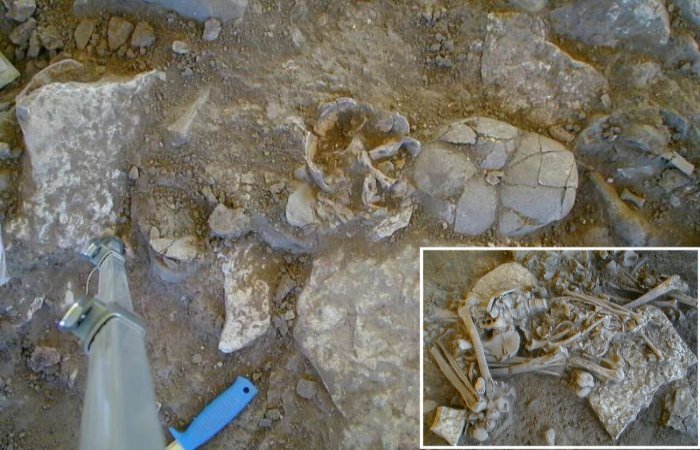DNA Analyses Suggest The Plague Contributed To Stone Age Farmers’ Decline

Conny Waters – AncientPages.com – Ancient DNA from bones and teeth suggests plague’s role in Stone Age population decline.
One of the complete skeletons found in the Frälsegården passage grave (Individual B/FRA043). The skeleton is that of a 30-40 years old woman, related only in the second degree to individuals in the kinship tree. According to strontium isotopes in her teeth she was born outside the sedimentary geology of Falbygden, probably in a neighboring region of western Sweden. The cranium was removed earlier during the excavation. Credit: Karl-Göran Sjögren.
New research in Nature suggests the plague may have reduced European populations earlier than previously thought, predating major Middle Ages outbreaks.
In 14th century Europe, the “Black Death” plague devastated the population, killing nearly a third of the people.
New research from the University of Copenhagen suggests the plague arrived in Scandinavia thousands of years earlier than previously thought, possibly causing an epidemic despite contrary theories.
Researchers from the Globe Institute and the University of Gothenburg analyzed DNA from 108 ancient teeth and bones dating back 5, 000 years.
“The analyses show that 18 of these individuals, 17%, were infected with the plague when they died. Furthermore, our results suggests that the youngest plague strain we identify might have had epidemic potential,” says postdoc Frederik Seersholm, who led the DNA analysis.
The plague may have contributed to the Neolithic decline, a population collapse 5, 000 years ago that caused many farmers in Scandinavia and Northwestern Europe to disappear within a few centuries.
“We cannot—yet—prove that this was exactly how it happened. But the fact that we can now show that it could have happened this way is significant. The cause of this population decline, which we have known about for a long time, has always been subject of debate,” says Seersholm.
The plague may have contributed to the Neolithic decline, a population collapse 5, 000 years ago that caused many farmers in Scandinavia and Northwestern Europe to disappear within a few centuries.
“We cannot—yet—prove that this was exactly how it happened. But the fact that we can now show that it could have happened this way is significant. The cause of this population decline, which we have known about for a long time, has always been subject of debate,” says Seersholm.
The archaeological material analyzed comes mainly from passage graves in Sweden, but one of the individuals is from a stone cist in Stevns, Denmark.
The skulls of the two second generation individuals in the right branch, FRA022 and FRA023, placed beside a limestone slab covering the ancestral individual, FRA021. Credit: Karl-Göran Sjögren.
Researchers used “deep shotgun sequencing” to extract detailed information from ancient DNA in Neolithic tooth and bone samples. This method allowed them to study familial relations and diseases despite the DNA’s degraded state.
“We’ve mapped plague lineages and described other microbes in the DNA data. Our analysis also examined human DNA from broad to individual levels, providing insights into the social structure of that time,” saaccording to Associate Professor Martin Sikora from the Globe Institute, who led the study.
DNA analysis revealed plague in 17% of individuals, suggesting its prevalence in late Stone Age Scandinavia. One analyzed family experienced at least three plague outbreaks over six mapped generations.
“For 200 years, we’ve debated kinship relations among individuals found in megalithic tombs. While theories abounded, DNA now provides concrete data,” according to Karl-Göran Sjögren, Associate Professor of Archaeology at the University of Gothenburg.
The new results of this study rule out previous theories suggesting that the population decline could not have been caused by plague.
According to Seersholm, “theories about Neolithic population decline include war and infectious diseases, like plague. While some argued plague couldn’t cause an epidemic, this assumption is now challenged.”
Written by Conny Waters – AncientPages.com Staff Writer






